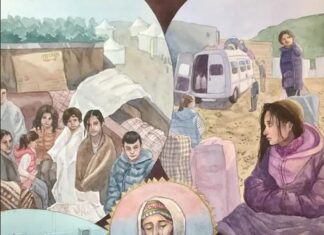Book of Genesis (Yearbook, Inc. 2014) by Siran Seza is the story of Astine, the daughter of an upper middle-class Armenian family living in Constantinople (present-day Istanbul), a cosmopolitan city at the crossroads of Europe and Asia, in the early 1900s. With its splendor and its vibrant cultural life — lectures, concerts, theatrical offerings every night — the metropolis provides the perfect environment for the precocious child, a lover of the arts and an avid reader, to become the “famous writer and poet” that the noted painter and poet Diran Chrakian, a family friend, predicted she would be. The gifted young girl grows up surrounded by the literary giants who have become household names for us all. On her way to school, she runs into Siamanto and Gomidas. Zabel Yessayan lives next door. Zabel Asadour is a family friend.
It was late in life that Seza decided to write a novel based on her life experiences and her memories of the people and the events of the city she lived in until her early 20s. Making direct connections between the spirited and fearless protagonist and the outspoken and defiant author, whose name has become synonymous with the advocacy for the Armenian woman’s rights, should not be difficult. Indeed, Seza sometimes used the pen name Astine to sign her articles in The Young Armenian Woman, the pioneering literary journal she started publishing in Beirut, Lebanon, in 1932, dedicated to expanding opportunities for women, both Armenian and Arab. Astine’s father, nicknamed Zarif Diran, evokes Siran Seza’s birth name, Siranush Zarifian. There are numerous parallels, yet Astine does not stand directly for the author. She is a created persona.

Nonetheless, Book of Genesis depicts a world rooted in truth. With her painstakingly detailed descriptions Seza creates a vivid picture of the streets and the neighborhoods of Scutari, the suburb thriving with Armenian life where Astine was born. She describes the windy roads that lead to the red benches on the shores of the Marmara where the adolescent girl would sit with Armen, the student she truly cared for. Nature is ever-present. Astine loves lilacs and roses and the aroma of strawberries.
“The beauty of nature nourished her soul,” writes Seza. When Armen breaks up with her, Astine sits at the water’s edge watching the “hopeless waves.” Nature is sympathetic, always soothing,
With her details and her images Seza makes the horrors of the breaking war palpable. Astine’s dread of the pointed whiskers of the Turkish officer who visits her school, or her panic when the Turk sitting next to her in the train places his hand on her lap, corroborate the news of the indescribable horrors being committed in the inner villages. “Why are the Turks a proud race,” when they are “filthy,” “hateful,” “beastlike” and “full of animal instincts,” asks the frightened girl. When Sultan Hamid is dethroned and she witnesses the splendor and the extravagance of the Yildiz Palace, now opened to the public, “Why is a magnanimous Sultan with such an exquisite taste such a bloodthirsty beast,” she wonders. Indeed, Astine’s endless questioning and brooding over the “fate of the Armenian people” foreshadow the ongoing massacres and displacements of the Armenian people. They give immediacy to the young girl’s insights into the unprecedented fears of the Armenians and the Greeks who had been subjects of an oppressive regime for centuries. Her, “Can one trust an oppressor’s promises?” has an eerie relevance.
The events of the novel unfold as “Hani would tell” them, or as Astine recalls them as “told to her by her mother.” Grandmother Hani and her mother are, in fact, the child’s favorite people. The delicate fragile daughter prone to frequent headaches comes from a lineage of powerful women who comfort and reassure when others distress and anger. When she is upset and goes straight to her room, skipping dinner, the older women understand. And while there is no direct advocacy in the novel of the crucial role a woman can play in improving the life of her community, having a female protagonist of unusual self-confidence and sensitivity can be very empowering for “the female sex” to whom the novel is dedicated.










